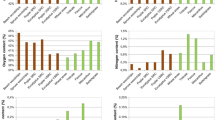Abstract
The rational and sustainable exploitation of natural resources is one the priority objectives of our consumer society as an unavoidable strategy for survival. In previous articles, research group TERBIPROMAT has established the bases for the elaboration of energy maps of forest biomass. With those data, it is possible to classify the species in terms of their energy content and of their possible application as biofuels following European Norm CEN/TS 14961/2005 on solid biofuels. Main forest species used in this study were Populus and Paulownia. These species have a fast growth and produce big amounts of energetic biomass. To complete this study a comparison with autochthonous forest species, Eucalyptus and Pinus, was made. In this study, a thermogravimetric analysis is employed to qualitative study the resistance to thermal degradation of different forest species. These studies complete those made through static bomb calorimetry, elemental analysis, and different mechanical tests trying to get relationships between thermal behaviour and some physical properties.



Similar content being viewed by others
References
Ministerio de Agricultura, Pesca y Alimentación, Tercer Inventario Forestal Nacional. 1997–2006, Madrid:Ed. Ministerio de Medio Ambiente 2000.
PLADIGA 2010. Consellería de Medio Rural. Dirección Xeral de Montes. Xunta de Galicia. 2010. http://mediorural.xunta.es/fileadmin/arquivos/forestal/pladiga/2010/1_MEMORIA_WEB_PLADIGA_2010.pdf. Accessed 14 Sep 2010.
Núñez-Regueira L, Proupín-Castiñeiras J, Rodríguez-Añón JA. Energy evaluation of forest residues originated from Eucalyptus globulus Labill in Galicia. Bioresour Technol. 2002;82:5–13.
Forest products laboratory, Word Engineering Handbook, New Jersey: Prentice; 1990.
Ragland KW, Aerts DJ, Baker AJ. Properties of wood for combustion analysis. Bioresour Technol. 1991;37:161–8.
Kemp RB. Nonscanning calorimetry. In: Gallagher PK, editor. Handbook of thermal analysis and calorimetry. Amsterdam: Elsevier; 1999. p. 1032.
ASTM D3173-03 (2008) Standard test method for moisture in the analysis sample of coal and coke.
Blake GR, Hartge KH. Bulk density. In: Klute A, editor. Methods of soil analysis, part 1 physical and mineralogical methods. 2nd ed. Madison: American Society of Agronomy, Inc. and Soil Science Society of America, Inc; 1998. p. 363–75.
Blake GR, Hartge KH. Particle density. In: Klute A, editor. Methods of soil analysis, part 1 physical and mineralogical methods. 2nd ed. Madison: American Society of Agronomy, Inc. and Soil Science Society of America, Inc; 1998. p. 377–82.
Forest products laboratory. Wood handbook: Wood as an engineering material. Agric. Handbook t2 (rev) Washington, DC: US Department of Agriculture 1987.
Hubbard W, Scott D, Waddington G. Experimental thermochemistry, Rossini F., 1, Chap. 5. New York: Interscience Publishers Inc; 1956. p. 77–87.
Núñez-Regueira L, Rodríguez-Añón J, Proupín-Castiñeiras J, Labarta-Carreño C. Use of bomb calorimetry to assess recovery of waste industrial mineral oils through regeneration. J Therm Anal Calorim. 2002;70:93–101.
ASTM E872-82 (2006) Standard test method for volatile matter in the analysis of particulate wood fuels.
ASTM D3175-07 (2006) Standard test method for volatile matter in the analysis sample of coal and coke.
ISO 562:2010 Hard coal and coke-determination of volatile matter.
Standard test method for ash in Wood D 1102-84 Reapproved 2007.
ASTM D3174-04 (2003) Standard test method for ash in the analysis sample of coal and coke from coal.
ISO 1171:2010 Solid mineral fuels-determination of ash.
Liodakis S, Bakirtzis D, Lois E. TG and autoignition studies on forest fuels. J Therm Anal Calorim. 2002;69:519–28.
Kwok QSM, Jones DEG, Nunez GF, Charland JP, Dionne S. Characterization of bio-fuel and bio-fuel ash. J Therm Anal Calorim. 2004;78:173–84.
Strezov V, Moghtaderi B, Lucas JA. Study of decomposition of selected biomass samples. J Therm Anal Calorim. 2003;72:1041–8.
Leroy V, Cancellieri D, Leoni E. Relation between forest fuels composition and energy emitted during their thermal degradation. J Therm Anal Calorim. 2009;96(1):293–300.
Cuña Suárez A, Tancredi N, Pinheiro CPC, Yoshida MI. Thermal analysis of the combustion of charcoals from Eucalyptus dunnii obtained at different pyrolysis temperatures. J Therm Anal Calorim. 2010;100(3):1051–4.
Núñez-Regueira L, Rodríguez-Añón JA, Proupín J, Mouriño B, Artiaga-Diaz R. Energetic study of residual forest biomass using calorimetry and thermal analysis. J Therm Anal Calorim. 2005;80:457–64.
Author information
Authors and Affiliations
Corresponding author
Rights and permissions
About this article
Cite this article
Villanueva, M., Proupín, J., Rodríguez-Añón, J.A. et al. Energetic characterization of forest biomass by calorimetry and thermal analysis. J Therm Anal Calorim 104, 61–67 (2011). https://doi.org/10.1007/s10973-010-1177-y
Published:
Issue Date:
DOI: https://doi.org/10.1007/s10973-010-1177-y




